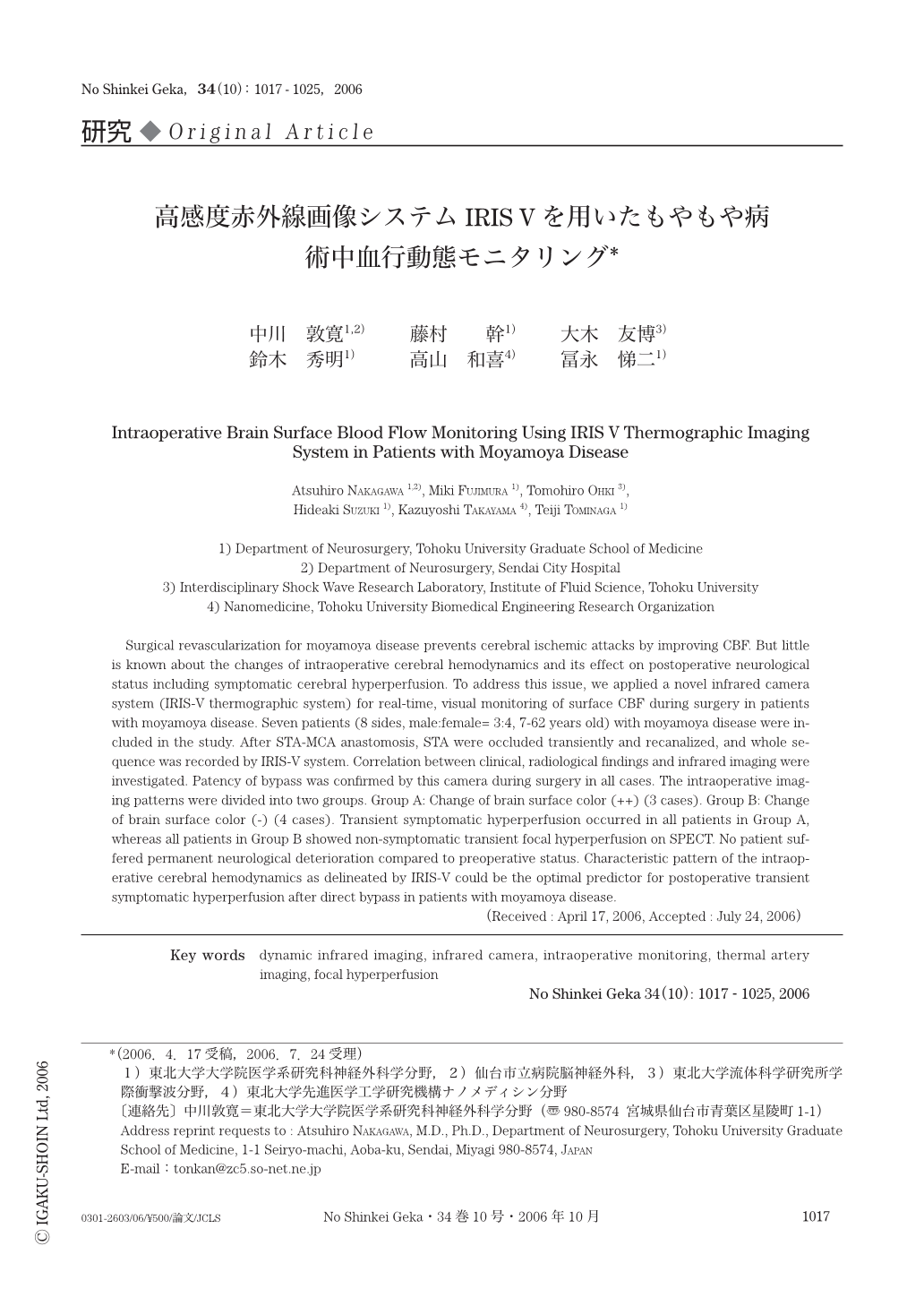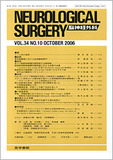Japanese
English
- 有料閲覧
- Abstract 文献概要
- 1ページ目 Look Inside
- 参考文献 Reference
Ⅰ.は じ め に
もやもや病は両側内頸動脈終末部,前および中大脳動脈近位部が進行性に狭窄,閉塞し,その付近に異常血管網の発達を認める原因不明の疾患である17).浅側頭動脈・中大脳動脈(STA-MCA)吻合術は,本疾患による脳虚血を改善するための有効な治療法として広く用いられている7,8).その一方で,もやもや病患者では吻合術後2,3日目に始まる,手術側の脳に一過性の神経症状が出現することが知られている.術前に虚血発作を多く呈しており,脳血流の低下が著明な症例で多く認められる傾向にあり,機序に関しては脳血流検査(SPECT)上局所的に低灌流を示す症例もあれば,一過性に吻合部位に限局した過灌流を呈する群が含まれることが報告されている2,4,12,18).その病態に関しては不明な点が多く,臨床症状のみから両者の鑑別は困難であるものの,治療方法は大きく異なり,過灌流を呈した症例では長期的に高次脳機能障害を起こす可能性があることから12),適切な診断とともに,より早期からの発生予測因子の解明が望まれる.
すべての物質は有限の温度をもち,その温度に応じて自ら電磁波(赤外線)を放射する(プランクの法則).また,熱輻射により放射される赤外線の波長分布と物体の表面温度は相関関係にある(ステファンボルツマンの法則).したがって,物質から放射される赤外線の強度(フォトン数)の分布を測定することにより,非接触的に物質の温度を測定することが可能で,間接的に局所血流量を測定することが可能である16).近年,高感度カメラの使用と情報処理の進歩により,形態描出能の改善のみならず血流画像,各種機能画像への試みが進められており5),一時血流遮断を要する心臓血管外科手術3,16)や,循環障害を伴う脳神経外科疾患の術中病態把握に極めて有効であることが報告されている1,5,13).われわれが開発を進めてきた脳神経外科手術用モニタリングシステムIRIS V infrared imaging systemは生体温に絞った熱情報を高い空間・時間解像度で撮影し,リアルタイムに鮮明な血管描出,脳表近傍の血流情報の可視化を目指したものである9).
今回,血行再建術を施行したもやもや病症例において,本システムを用いて術中血行動態モニタリングを施行し,術中所見と術後経過,特に一過性局所過灌流発生の関連について検討したので報告する.
Surgical revascularization for moyamoya disease prevents cerebral ischemic attacks by improving CBF. But little is known about the changes of intraoperative cerebral hemodynamics and its effect on postoperative neurological status including symptomatic cerebral hyperperfusion. To address this issue,we applied a novel infrared camera system (IRIS-V thermographic system) for real-time,visual monitoring of surface CBF during surgery in patients with moyamoya disease. Seven patients (8 sides,male:female= 3:4,7-62 years old) with moyamoya disease were included in the study. After STA-MCA anastomosis,STA were occluded transiently and recanalized,and whole sequence was recorded by IRIS-V system. Correlation between clinical,radiological findings and infrared imaging were investigated. Patency of bypass was confirmed by this camera during surgery in all cases. The intraoperative imaging patterns were divided into two groups. Group A: Change of brain surface color (++) (3 cases). Group B: Change of brain surface color (-) (4 cases). Transient symptomatic hyperperfusion occurred in all patients in Group A,whereas all patients in Group B showed non-symptomatic transient focal hyperperfusion on SPECT. No patient suffered permanent neurological deterioration compared to preoperative status. Characteristic pattern of the intraoperative cerebral hemodynamics as delineated by IRIS-V could be the optimal predictor for postoperative transient symptomatic hyperperfusion after direct bypass in patients with moyamoya disease.

Copyright © 2006, Igaku-Shoin Ltd. All rights reserved.


